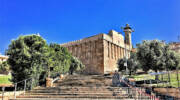Sukkot is a wonderful, joyful holiday – one of the three Torah festivals on which Jews everywhere were required to make a pilgrimage to Jerusalem.
By Rabbi Ari Enkin,
Rabbinic Director, United with Israel
Sukkot is a seven-day holiday, with the first day being observed as a holy day, similar to the Sabbath, upon which no work is permitted.
Outside of Israel the first two days are observed as holy days.
The remaining days of the holiday are referred to as “Chol Hamoed.” The Chol Hamoed days are not outright holy days but they are treated with more sanctity than regular weekdays complete with elaborate meals and nicer clothing. Family trips are common during these days.
Originally, Sukkot was more of an agricultural festival, as the Torah itself calls it: The Feast of Ingathering… when you gather in your labors from out of the field. (Exodus 23:16; Leviticus 23:40-43; Deuteronomy 16:13). It was a thanksgiving festival to God for the year’s harvest.
Today, it is observed more as a holiday of rest and reflection for the miracles that God did for the Jewish people when He led them in the desert for 40 years.
The word “Sukkot” means “huts” or “booths”, referring to the booth-like structures that Jews are to eat their meals in over the course of the holiday, and preferably to sleep in too!
What’s unique about these booths is that they are walled structures, usually from wood or canvas, but their roofs must be made of “schach” – organic material grown from the earth such as bamboo shoots, branches, or palm fronds.
Eating and sleeping in the sukkah is intended to remind us of the booths that the Jewish people built for themselves while wandering in the desert for 40 years. It also recalls the “clouds of glory” that accompanied the Jewish people throughout their desert trek, protecting them from the elements and other dangers that lurk on the desert floor.
Another prominent feature of Sukkot is the Lulav and Etrog bundle, also referred to as the “Four Species.” These four specific plants that are used during the course of the Sukkot prayers: the Lulav (a tall frond from a date palm tree), the Hadas (myrtle leaves), the Arava (willow leaves) and the Etrog (a citron fruit).
It is taught that the four species represent the four character-types among Jews:
The Lulav is a plant that has taste but no smell, symbolizing those who study the Torah but do not do enough good deeds; the Hadas has a good smell but no taste, symbolizing those who do many good deeds but neglect to study Torah as much as they should; the Arava has neither taste nor smell, symbolizing those who are lacking in both the study of Torah and the performance of good deeds, and the Etrog has both a good taste and a good smell, symbolizing those who both study Torah and perform good deeds.
May the holiday of Sukkot be a time for happiness and spiritual growth.
CHAG SAMEACH! Happy Sukkot to all of you!

Do You Love Israel? Make a Donation - Show Your Support!
Donate to vital charities that help protect Israeli citizens and inspire millions around the world to support Israel too!
Now more than ever, Israel needs your help to fight and win the war -- including on the battlefield of public opinion.
Antisemitism, anti-Israel bias and boycotts are out of control. Israel's enemies are inciting terror and violence against innocent Israelis and Jews around the world. Help us fight back!























